How to create a set of VMs using OpenStack Heat Orchestration
Heat is an OpenStack component responsible for Orchestration. Its purpose is to deliver automation engine and optimize processes.
Heat receives commands through templates which are text files in yaml format. A template describes the entire infrastructure that you want to deploy. The deployed environment is called a stack and can consist of any combination out of the different resources that are available in OpenStack.
What We Are Going To Cover
Typical parts of a Heat template
Basic template for using Heat
How to get data for Heat Template
Using Heat with CLI
Using Heat with GUI
More advanced template for Heat
Prerequisites
No. 1 Account
You need a Destination Earth hosting account with access to the Horizon interface: https://cloud.central.data.destination-earth.eu.
No. 2 OpenStack CLI client with the appropriate module
If you want to use Heat through CLI commands, you need to have the OpenStack CLI client installed and ready to use. The following article contains more information:
How To Install OpenStack and Magnum Clients for Command Line Interface to Destination Earth Horizon.
Apart from that, you will need to have the python-heatclient module.
If you used pip to install the OpenStack CLI Client, you can install this module using one of the commands below (depending on the environment you are running):
pip install python-heatclient
pip3 install python-heatclient
If you, however, installed the OpenStack CLI client using apt on Ubuntu 22.04, install the Heat client using the following command:
sudo apt install python3-heatclient
No. 3 SSH key pair
Your OpenStack environment needs to have an SSH key pair to perform the examples found in this article. You can add it by following one of these articles:
Always use the latest value of image id
From time to time, the default images of operating systems in the Destination Earth cloud are upgraded to the new versions. As a consequence, their image id will change. Let’s say that the image id for Ubuntu 22.04 LTS was 233656c2-2625-4b4f-a99f-d0663458e45a at the time of writing of this article. While working through the article, you would normally take the current value of image id, and would use it to replace 233656c2-2625-4b4f-a99f-d0663458e45a throughout the text.
Now, suppose you wanted to automate processes under OpenStack, perhaps using Heat, Terraform, Ansible or any other tool for OpenStack automation; if you use the value of 233656c2-2625-4b4f-a99f-d0663458e45a for image id, it would remain hardcoded and once this value gets changed during the upgrade, the automated process may stop to execute.
Warning
Make sure that your automation code is using the current value of an OS image id, not the hardcoded one.
How to write Heat templates
Here are the basic elements of a Heat template:
- heat_template_version
The exact version of heat template. Each of them varies in many ways (including support for various modules, additional parameters, customization etc). See Orchestration -> Template Versions.
- resources
Entry to commence providing particular components for deployment.
- instance
Name of resource (you can type in anything on your own).
- type
Definition of an OpenStack component (a comprehensive list is under Orchestration -> Resource Types)
- properties
Required parameters for deploying a component.
Example 1: Launching one virtual machine
Code
Using the following snippet, you can create one virtual machine with Ubuntu 22.04 (flavor eo2a.large) on a default project. Create a text file called template.yaml using your favorite text editor and add the content below to it:
heat_template_version: 2015-04-30
resources:
instance:
type: OS::Nova::Server
properties:
flavor: eo2a.large
image: 233656c2-2625-4b4f-a99f-d0663458e45a
networks:
- network: <cloud_johnsmith_1>
key_name: <mykey>
security_groups:
- allow_ping_ssh_rdp
- default
Important
YAML format does not allow using tabs, you must enter spaces instead.
In the code above, replace <cloud_johnsmith_1> with the name of the network found in your project and <mykey> with the name of the SSH key.
How to get data needed for describing a virtual machine in Heat
Templates need data for images, flavor networks, key pairs, security groups and so on. You would normally know all these elements in advance, or you could “look around” at various parts of the Horizon dashboard:
flavor |
Compute -> Instances -> Launch Instance -> Flavor |
image |
Compute -> Instances -> Launch Instance -> Source |
networks |
Network -> Networks -> cloud network for your domain |
key_name |
Compute -> Key Pairs |
security_groups |
Network -> Security Groups |
You can work with Heat in two ways:
through Command Line Interface (CLI), with python-heatclient installed and
using the Horizon dashboard in your browser.
Launching the Stack using Heat
If you launch a Stack using Heat, the infrastructure described in a Stack should be created. You can do that using the Horizon dashboard or the OpenStack CLI client.
Method 1: Using the Horizon dashboard
Log in to the Horizon dashboard, choose Orchestration and then Stacks tab:
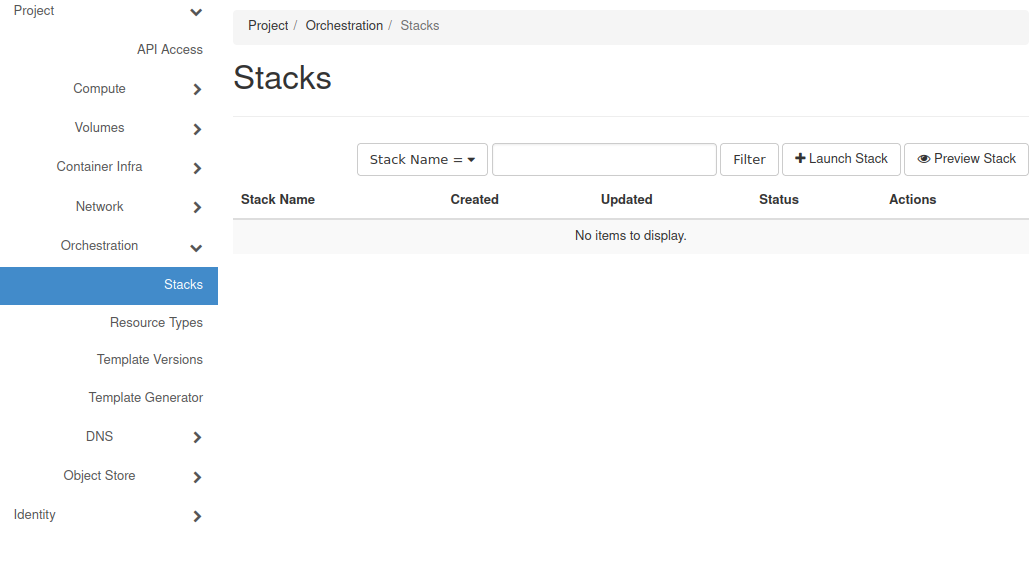
Navigate to the right part of the screen, click on button  and bring Select Template window to the screen.
and bring Select Template window to the screen.
From the drop-down menu Template Source choose the appropriate source:
File allows you to upload a file with the template.
Direct Input allows you to enter the template directly into a text field in the Horizon dashboard.
URL allows you to use a template available on the Internet - you can specify URL here.

In this example, choose Direct Input.
Copy the contents of the previously created template.yaml file to the Template Data text field:

Provide a name of your stack and the password for your Destination Earth account:
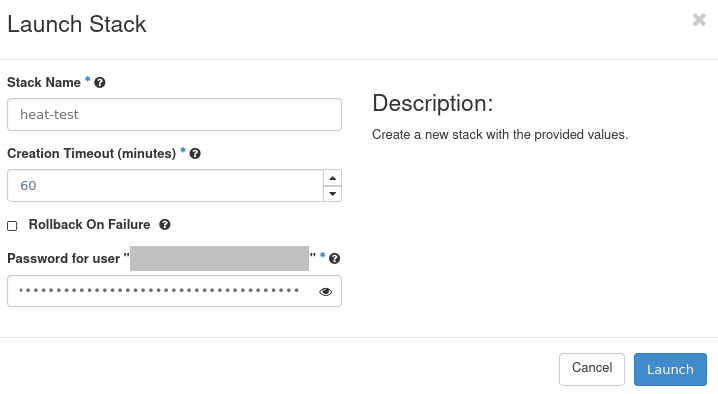
Click Launch.
The process of creating a stack should be started:
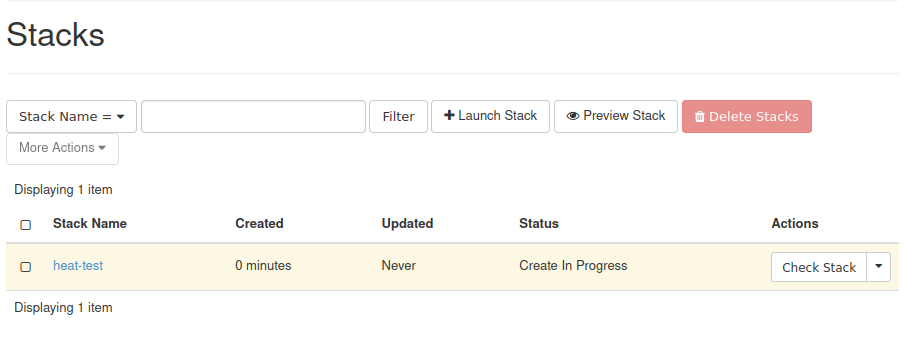
Once the Stack has the Status Create Complete, your new virtual machine should be available in the Compute -> Instances section of the Horizon dashboard:
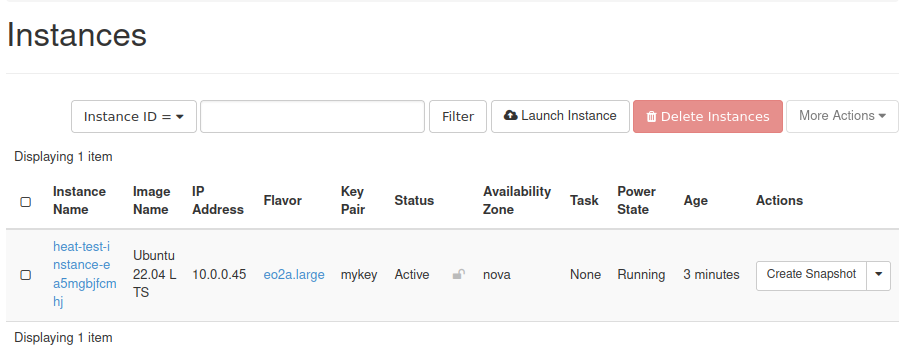
Method 2: Using the OpenStack CLI client
Make sure that you have the OpenStack CLI client with the Heat client module set up and ready to use (as explained in Prerequisite No. 2).
The command used to deploy the stack can then have the following syntax:
openstack stack create -t <filename> <stackname>
where -t assigns file from your local hard drive with a template for deployment (<filename>) and <stackname> defines name for the stack.
For example, if the name of the file is template.yaml, you are in the folder containing that file and you wish to call your stack heat-test2, this is how the command will look like:
openstack stack create -t template.yaml heat-test2
It should produce output like this:

You can use the openstack stack list command to list your current stacks:

Your new stack should also be visible in the Horizon dashboard:
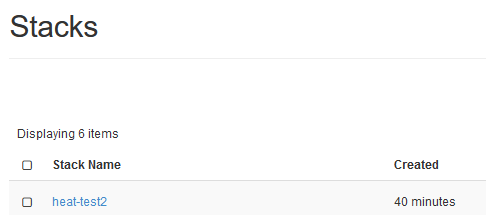
To list servers found in your project, execute openstack server list - this command should show your new virtual machine:

In this example, the optional parameter –fit-width was used so that the output looks better on this screenshot.
The virtual machine should also be visible in the Compute -> Instances section of the Horizon dashboard:

Example 2: Launching five VMs using an advanced Heat template
In this example, we will create four VMs which only have ephemeral storage and one VM booted from a volume, all using one template file.
Code
Below you can find the code for this example. Make sure to replace all values in <> brackets as explained in the code (after replacing, remove the brackets). For example, if the name of your SSH key is mykey, replace <insert your ssh key name here> in the code below with mykey.
heat_template_version: 2015-04-30
parameters:
key_name:
type: string
label: sshkey
description: SSH key to be used for all instances
default: <insert your ssh key name here>
image_id:
type: string
description: Image to be used. Check all available options in Horizon dashboard or, with CLI, use openstack image list command.
default: 233656c2-2625-4b4f-a99f-d0663458e45a
private_net_id:
type: string
description: ID/Name of private network
default: <insert your network name here, e.g. cloud_johnsmith_1>
resources:
Group_of_VMs:
type: OS::Heat::ResourceGroup
properties:
count: 4
resource_def:
type: OS::Nova::Server
properties:
name: my_vm%index%
flavor: eo2a.large
image: { get_param: image_id }
networks:
- network: { get_param: private_net_id }
key_name: { get_param: key_name }
security_groups:
- allow_ping_ssh_rdp
- default
VOL_FAQ:
type: OS::Cinder::Volume
properties:
name: vol
size: 20
image : { get_param: image_id }
With_volume:
type: OS::Nova::Server
properties:
flavor: eo2a.large
block_device_mapping: [{"volume_size": 20, "volume_id": { get_resource: VOL_FAQ }, "delete_on_termination": False, "device_name": "/dev/vda" }]
networks:
- network: { get_param: private_net_id }
key_name: { get_param: key_name }
security_groups:
- allow_ping_ssh_rdp
- default
image : { get_param: image_id }
outputs:
SERVER_DETAILS:
description: Shows details of all virtual servers.
value: { get_attr: [ Group_of_VMs, show ] }
After appropriate modifications, save the following code as template5.yaml
Explanation of the code
The four virtual machines which only have ephemeral storage are created as a ResourceGroup with counter. In parameter count we state that we want to generate 4 instances at once.
The fifth instance booted from a Cinder volume is created separately. First, we create a volume in the VOL_FAQ section and then we create a VM in the With_volume section.
- Parameters
Here you provide default values (key_name, image_id, private_net_id in this case) and later inject them into resource definitions. The syntax is:
{get param: param_name }- ResourceGroup
Component being used for repeating deployment, e.g two identical VM’s.
- Count
Defines a variable for iterative operations.
- resource_def
Starting statement for defining group resources.
- %index%
This is how you add iterative number to the VM name, increasing values starting from 0.
- block_device_mapping
Property to define a bootable Cinder volume for instance.
- outputs
Additional information concerning deployed elements of the stack. In this case it returns a “show” attribute output. You can examine this kind of information by using openstack stack output list. Available attributes for every component can be found here..
Launching the Stack using Heat
Execute the template with the following command:
openstack stack create -t template5.yaml five
The name of the stack will be five. This is the result in CLI window:

Once the building of virtual machines is over, the new instances should be available in the Compute -> Instance section of the Horizon dashboard:
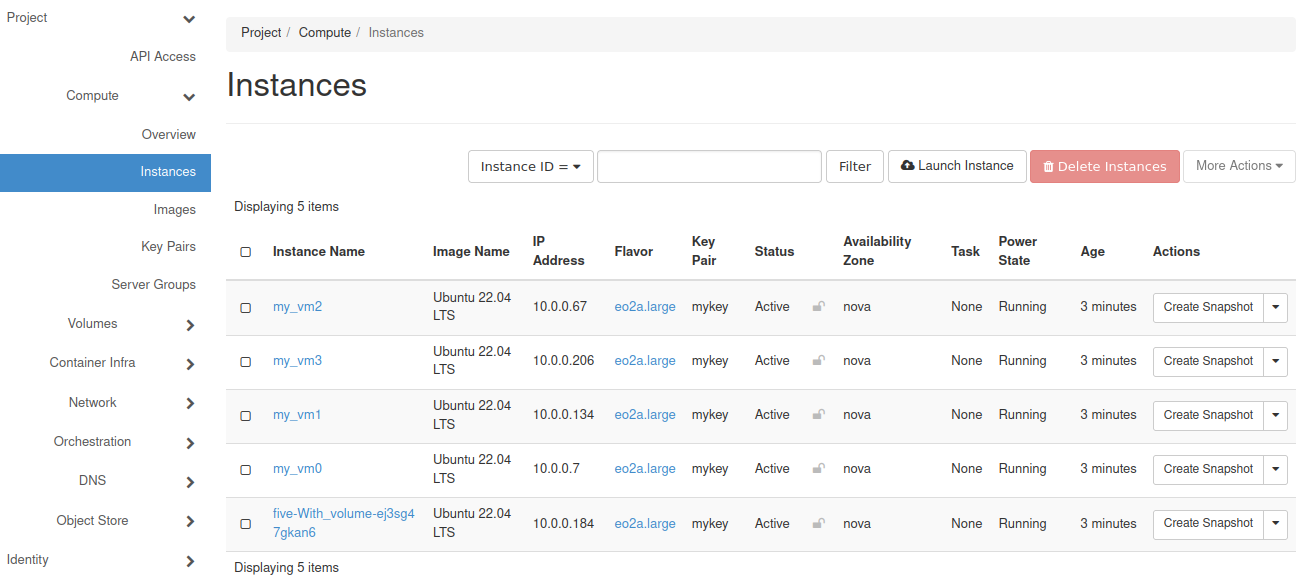
Four of them have names my_vm0, my_vm1, my_vm1 and my_vm1, as defined in line name: my_vm%index% in the template.
The name of the fifth VM starts with the name of the stack - five - and is proceeded by the name of the section of the template responsible for its creation - With_volume and the final part of the name is generated automatically (in your case it might be different).
What To Do Next
Apart from writing your templates as yaml files manually, you can also use option Orchestration -> Template Generator, which will enable you to enter components in an interactive way:

Further explanation of this option is out of scope of this article.